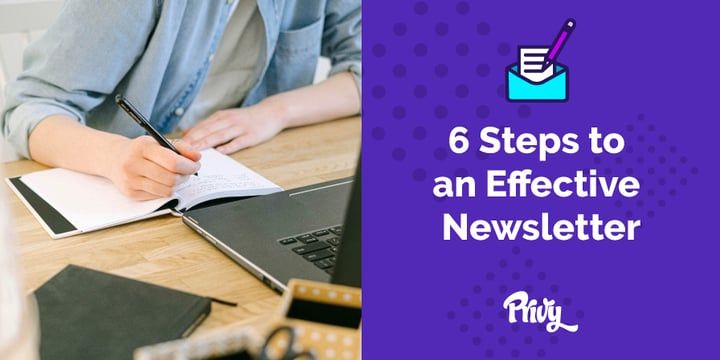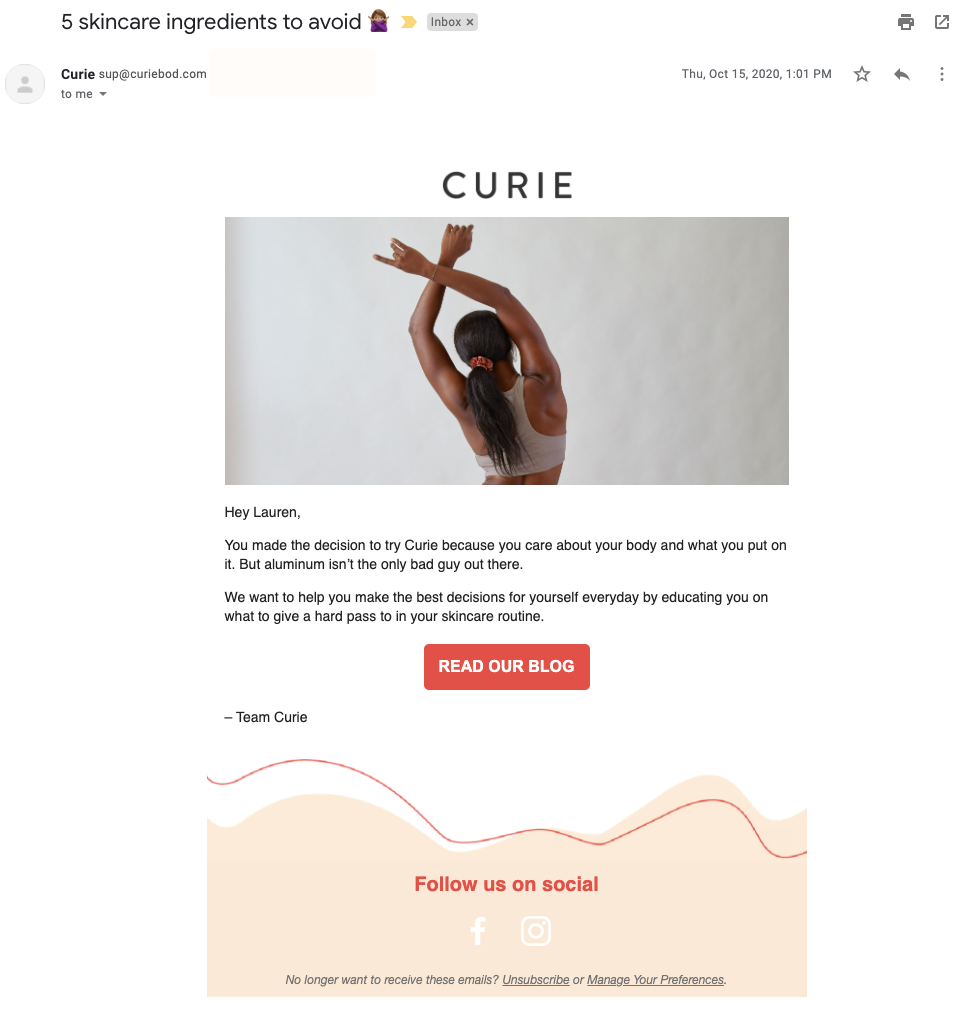How To Write An Effective Newsletter Email
Newsletter emails are a critical part of your email marketing strategy. Here are 6 steps for writing effective newsletters for your ecommerce business that will help you build relationships and get sales.

Written by Ivanha Paz
Emails are a great way for you to connect with your customers.

They help establish a personal connection with your subscribers at scale - building community and reminding them you’re here.
Because it’s all about top of mind and organic relationships, pretty much the best way to do marketing.
But chances are, if you’re here you already know that...
Still, before we get into how to actually write a newsletter email, it’s important to go over the point of it all.
Because if you understand why newsletters are so important for your business, you’re already halfway there (and one step ahead of many of your competitors).
Think about the newsletters you receive...which ones do you read religiously? Why?
You’ve probably got a mix in there of newsletters from brands you admire, others from brands that you actually use, and others that you’ve just been too lazy to unsubscribe from, but never open.
So with that in mind, let’s break down what an effective newsletter actually does:
- Informs readers of important information about your business/products/services
- Gives them free value with content they can use
- Relates to your readers’ lives by giving them solutions to problems they know (or don’t know) they have
- Builds brand loyalty by setting an expectation of quality and timing
Sounds pretty sweet right? It is. But it can also be quite difficult. Just think about all the email lists you've been wanting to unsubscribe from. Well, that’s exactly the feeling you want to prevent.
You don’t want your customers to feel like they’re selling their soul by giving you their email address.
But remember, standing out and getting those opens, is more difficult than ever. Your newsletter might not be for everybody, and that’s ok. It’s much more valuable to have a clear concept, appealing to a niche audience than trying to be everything to everyone.
Cool, so how do you write this thing?
Start by thinking about your audience and who they are, then write to them. What’s the reason that they come to your site to buy stuff? What problems are you solving?
Write about them.
Some tips:
- Keep it casual.
- Write like you talk.
- Don’t include so many links — try to keep as much information as possible inside the newsletter, so that the CTAs you do have in there have a better chance of standing out.
- Don't try to be too corporate — you don’t need an amazing, superbly designed template, instead make it feel like it’s a friend sending them an email.
- Send it from a person’s email address and write it in the first person.
You might be thinking, "Do I really need a newsletter for my business?"
The answer is yes. Hands down yes. And in this post, we'll be covering:
- Why you should have a newsletter
- Basic elements of a newsletter
- 6 best practices for how to write your newsletters
- How often you should send newsletters
- Why you should always be testing your newsletters
- Newsletter FAQs
Get our best content on ecommerce marketing in your inbox 2 times a week
Why should your business have a newsletter?
The truth is, your business should have a newsletter because if you send these emails frequently enough, you'll be able to drive predictable revenue from them.
After your automated emails are up and running, it's time to start thinking about your one-off newsletters as part of your larger email marketing strategy.
If social media helps you build awareness, your newsletter is about the next steps: consideration, decision and ultimately retention.
Basic elements of an email newsletter
The best newsletters tend to follow the same structure, and while it might vary from business to business, here are some elements of an email newsletter to get you started:
Enticing subject line
As a general rule, subject lines shouldn’t be longer than 10 words (any longer and it will get cut off).
Draft your subject lines thinking it’s your only shot to grab your reader’s attention, but they also have to be relevant to what the email is about.
For example, if you're sharing something like a new blog post, you could use part of the title as your subject line, like Curie did here:
Just remember: effective subject lines take practice, but once you get in a groove, it won't take long to figure out what works with your audience.
Some more guidelines for subject lines to help you get more opens:

- Create a sense of urgency (promo ending tomorrow, for the next 10 hours, first 25 replies…)
- Inspire curiosity by trying to pique your readers’ interest about what’s inside, ask a question, use impressive stats
- Have some fun! Puns, jokes, try it all
Preview text
That’s the little snippet of text right after your subject line.
And it's your second chance to get that open. Think of it as a sneak peek into what’s inside. Use your best piece of content, or the most surprising thing in the email, you can also put some numbers in there, or highlight a special offer.
If you're between 2 subject line ideas, use the preview text as your opportunity to get both in there!
Title
Now we’re talking about what’s actually inside your newsletter. This isn’t strictly necessary, but it’s a good way to keep your content engaging and encourage your readers to read on to the next few lines. You can write a header or title for your email that summarizes the rest of it. You can even use the same format each time, for example:
[Business Name] Weekly: Everything You Need to Have a Fun Summer During Quarantine.
Or if you're featuring a handful of your best-sellers, for example, why not make that extra clear?
Featured Content
You can also choose to feature towards the top the place you’re most interested in sending you readers to. Whether it’s a blog post, landing page, or special product, you can highlight it at the top and make it your first Call to Action (CTA).
Good content
You can have an amazing subject line, killer product, and something your subscribers might genuinely want.
But if the content in your newsletter isn't amazing, you're never going to get them to click and head to your store. Or more importantly, land that sale!
Pictures/GIFs
Including images isn’t a must, but it helps.
Here’s your chance to show some personality with GIFs or memes, as well as cool images that showcase your brand and products.
Clear and few CTAs
Your CTA is the action you're hoping your readers to take.
If you're featuring a brand new product, you probably want them to head to your store to look at the product.
If you're sharing a new blog post, you want them to read it.
But it's important to remember your CTAs should be super clear and visible. And you don't want too many in the same newsletter (more than 2 is probably too many!).
Social share buttons
Social share buttons are rarely clicked…but you don’t lose anything by including them. Keep them small and at the bottom so your readers know which platforms you’re on and can go to them directly.
Unsubscribe link
And of course, you need to include a way to unsubscribe in the footer. Make it easily visible, don’t try to hide it. People should be opening and reading your newsletter because they like it, not because they can’t figure out how to unsubscribe.
6 best practices for how to write email newsletters
Let’s back it up for a second.
We know the purpose of email newsletters: providing free value, posing solutions to problems, promoting your products, engaging with your community, staying relevant, and building loyalty.
And we’ve got the basic elements, it's time to dive into the finer details of how to write email newsletters.
1. Establish a tone and stick to it
Even though it's coming from a specific person, your newsletter should reflect your brand voice.
It needs to be in line with your tone across all your advertising channels. Your subscribers joined your list because they like you, so give them more of what they like.
2. Stay away from technical jargon
If you’re selling complicated products, focus on the solution and benefits instead of how it works or what the product has.
Your customers probably don’t care, they just want to know it works and how it’s going to help them.
3. Write like you talk
Keep it casual. Use emojis, short sentences, white space, and bullet points.
Imagine you’re writing the email to your mom. What words would you use?
Use humor when appropriate, and use your messaging to establish rapport. You can ask questions, take a stand on current events, share real stories, you can even get personal and briefly share details about your life if they're relevant. Put yourself in their shoes.
4. Keep your emails short
If you have to click view more inside the email, you’ve gone too far.
Think about what people are doing when they’re reading a newsletter from their favorite brand.
They’re usually on their phone while they're watching TV, or in bed, or taking a quick break from work.
Their attention probably isn’t completely focused on your email, so you need to make sure you're getting to the point quickly and keeping it short and sweet.
5. Include links to the most important things
Use links sparingly. The more links you have, the more competition you’re creating in your own email.
So think about where you really want them to go and point readers there without too many other distractions.
6. Keep as much info as possible inside the email
Keeping your emails informative and entertaining becomes a lot easier when you’re not so focused on click through rates, but rather what’s inside. The rest will come naturally.
Pro Tip: Avoid Grammatical and Punctuation Mistakes
When sending email with your business name, you not only communicate with your audience but also represent your entire empire. As the first impression is always seen to be the lasting impression, so don’t try to ruin it in front of your audience with little mistakes.
Send flawless email of quality to your audience. There are many free grammar checking tools available online you can use to identify mistakes and eliminate them. Moreover, it will help you keep the standard of a native speaker. Moreover, it will make your email content readable, easy to understand with clear content.
How often should I send newsletters to my customers?
This one really depends on your business and resources. Maybe you’re a small team, maybe you’re the one writing these newsletters. If you can only carve out time once a month, then send them once a month.
The most important part of your newsletter cadence is sticking to it, since you’ll be creating an expectation (and hopefully getting your subscribers excited to hear from you). So, if you start out sending your newsletters twice a month, then suddenly stop, that’s not so great.
That being said, there’s a general benchmark that indicates that 61% of people who sign up to receive a newsletter like to get them once a week. So, the sweet spot is once a week, but if you're not sending a newsletter at least once a month, you're not sending them enough.
Always be testing your newsletters
Now you have a bunch of tips and guidelines to write effective newsletters, but really the best thing about newsletters is that they’re a chance to be unique and show who you really are. And they give you a chance to have some fun and test what works for your readers.
Testing your newsletters is an important part of getting better, increasing open and click-through rates, and figuring out the formula that resonates with your audience so you can repeat it.
Here are some basic tests you can run:
Send time
Try sending your newsletters early in the morning, late afternoon, at night, in the middle of the day...then check your open rates. Which times get the most opens?
But remember that the content of your email is way more important than when it goes out.
If your email isn't good, it's not going to matter when you sent it.
Send frequency
You can also test how often you send your newsletters early on.
Since you want to create an expectation for your audience is going to hear from you, it's important to figure out what your sweet spot is. Once a week is a safe cadence, but only testing will give you the most accurate data for your subscribers.
To determine the success of your send frequency, test a few different frequencies and see how your audience responds: how many opens you get, your click-through-rates, and how it’s impacting your bottom line: sales.
Tone and format
You can play around with different formats, using templates or going for a more casual email look. Find out what gets you the best response, emails with more text, emails with more pictures, number of CTAs, type of content, etc.
Also test your tone. You don’t want to steer too far from your brand voice, but you can test how humor lands, if personal stories work for your audience, what types of anecdotes to share, and more.
But usually blending education with entertainment is the way to go.
Email Newsletter FAQs
You’re almost ready to write killer newsletters that will help you engage with your community, keep them loyal to your brand, and get those sales up.
Some final email newsletter FAQs to address:
What are key things to include in a newsletter?
New products, discounts, special offers, and free useful content are all great reasons to send a newsletter to your list.
What problems does your product solve and how? Always think about the end benefit for your customers and write about it. You can also keep them in the loop about market trends, show them real-life situations, industry news, and company updates.
What are the benefits of starting a newsletter?
Starting a newsletter is low-hanging fruit to connect with your audience in more personal ways. It’s a chance to write to them with a set frequency, stay top of mind, showcase new stuff, and set yourself up as an expert in what you’re selling.
How to connect with customers through email newsletters?
By keeping your newsletter authentic (and using a few personalization tokens) you’ll be able to establish connections with your subscribers.
If they’ve subscribed, chances are you know what they like — you and your business! Strengthen your relationship with your audience by giving them more of what they want.
What's a good open rate for newsletters?
In ecommerce, the average open rate for newsletters is 20.4%. But it's even more important to understand your own open rates.
Once you start sending newsletters regularly, you'll be able to pinpoint exactly what you should be targeting in terms of open rate and know right away if your message is resonating with your audience.
And there you have it. You’re ready to start your newsletter, or tweak the one you’ve got. Just be yourself, tell your story, and get ready to start driving sales for your store with your emails.
If you want to see how your other metrics stack up, check out this post on email marketing benchmarks.
Start sending your newsletters for FREE today with Privy.
Writen by Ivanha Paz

Ivanha is a content marketer for SaaS/B2B. She's on a mission to bring some fun into B2B, you'll usually find her writing lots of techy things in non-technical ways.
You may also like to read
Learn how we responsibly build, test, and refine AI models and capabilities to ensure accuracy and domain relevancy.
Privy’s Email Automation Playbook: Ready-to-Use Formulas To Steal (Even If You're Not An Expert)
Want to bring in sales for your store 24/7? Here's what you need to know to activate the 4 most important email automations for your store ASAP.
Every Shopify Store Should Be Sending These 18 Types Of Newsletters (With 245+ Examples From Real Brands)
Consistency is key for building a successful email marketing calendar. But what exactly should you be sending? Here are 245+ examples and 18 types of emails to steal.
How to Create a Stunning Email With Privy: 15+ Design Tips and Best Practices
A well-designed email is key to communicating with your audience, building engagement and trust, and driving sales. Learn these 15+ tips and tricks for creating beautiful and effective emails in Privy.
